These descriptions are meant as a general guide as with each application the approaches will vary. It is essential to read as much information from other sites and books, and experiment with each approach to gain an understanding of the various applications. The same sound as mono from both speakers will only be heard as centred when sitting in the sweet spot in the center of both speakers. With mono sound any position of center that results in a greater than a 4dB difference between the speakers will appear as the sound is coming from the nearest speaker only.
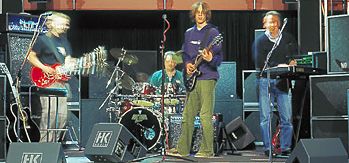
The traditional approach for a rock/pop band is to use robust dynamic cardioid microphones at very close distances. The aim is make the music as loud as possible, through what is often a high powered, low fidelity, often distorted mono PA system. Some Pop musicians take little to no interest in how they are heard by the audience, this they believe should be managed by others. However many are obsessed by hearing their fold-back wedge monitors as loud as possible before feedback. Achieving loudness with minimum feedback is what governs what mics and techniques are used. Rarely do pop musicians become interested in specialised microphone techniques for creation of spatial sound-scaping.
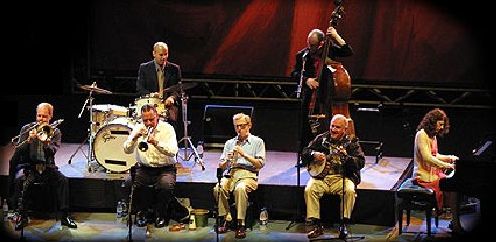
The above pic of the Woody Allan Jazz Band (of which I am a fan) is an excellent example of the basic correct principles of traditional live mic placement. The musician are well spaced for stage presence and best spatial microphone positions. Experience is required to know which microphone type is best suited to a particular production. In most application microphones are placed directly in front at a correct distance of each performer. This traditional approach is appropriate for applications where it is important to maintain a simple and constant outcome.
3:1 rule The often stated generalised rule is that the distance between mics should be at least x 3 greater that the distance between any one mic and the source. This simply means that the difference between mics hearing the same sound must be greater than 6dB. Following this simple rule will minimise the comb filter effect between mics.
Stereo applications to achieve sound scaping and increase depth of field require stereo application for almost every instrument or section of instruments. There are many stereo dual and triple mic techniques that place the microphones close together at varying angles which give slightly different results.

Each geometric arrangement is given a name.
- XY technique
- ORTF technique
- Decca Tree
- M&S Mid and Side or BDT Blumlein Difference Technique
- Coincident figure 8
It is essential to experiment with each arrangement to familiarise yourself with its behavioural pattern. There is no one arrangement that suits all applications. Each technique has an advantage for particular applications. Links to other web sites that give detailed explanations to the different names for each microphone arrangement are on the bottom of this page. If you are required to record as a team especially with trainees then each technique should be memorised with its correct name.
If you record on your own and have a good understanding of basic geometry and wavelength theory, you will be able to create the best outcome pattern without having to know the names for each arrangement. If you can find a geometric arrangement that has not already been named, you can claim it for yourself, similar to early explorers that have mountains named after them.
Innocent Ear by Chris Burmajster (Essential reading)
DPA Microphone University
A general rule is to achieve a difference in the sound level received by the mics of 6dB or greater. Sound level differences less than 6dB between mics will achieve a limited stereo effect but only if the listener is exactly in the middle between the speakers. Otherwise the sound will appear to come from the speaker closest to the listener as in the right pic below.
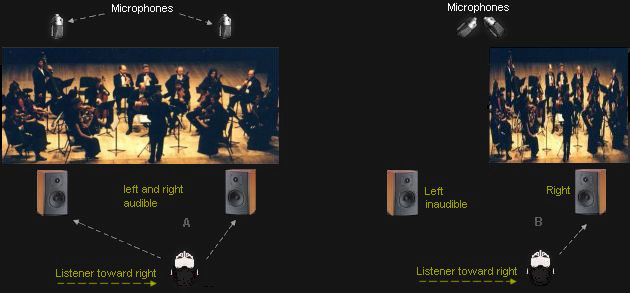
The above pic is a generalisation of showing the difference results between two basic stereo miking techniques. Placing two mics close together in any arrangement can enable the same sound to be heard by both, as mono, particularly the lower frequencies. The differences between some of the techniques can be subtle and it is essential to experiment with each approach to gain an understanding of the various applications. The intention of placing two mics close together is to achieve a similar outcome as with our ears. But when listening to the result through speakers from any position off-center between the speakers, it will appear as the sound is coming from the nearest speaker only.

Stereo miking with short shotguns over a drum kit (percussive transients) gives the best demonstration of spatial detail that can be achieved, when each mic is recorded separately and played back through separate speakers. The depth of field heard by the listener tends to remain constant over a wide listening angle. However if mixed to mono the listener would only hear the nearest speaker and the depth of field enabling a 3D image would disappear.
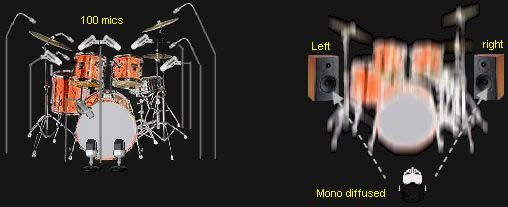
A common practice for pop music is to use a multitude of mics around the drum kit. As many as 20 mics can be used as in the above pic. The large number of mics interact creating an extreme comb filter effect which removes separation and transient detail. The mics are mixed to mono with added hyper-compression and short delays giving a thick fat percussive diffused wash. Two overheads may be added for stereo separation. There is simply no right or wrong in application of microphones for pop music, which is often driven by trends, momo-tonous conformity and a religious attachment to microphone brand names.

The above pic is an example of application choices by deciding the required outcome. Placing a single mic at a distance will insure the image is small. If mixed to mono the external comb-filter from the 2 speakers will diffuse transient and harmonic detail. Stereo close miking with each mic to each speaker will result in a larger than life image of the instrument, which will exaggerate both transient and harmonic detail. The size of the image is not dependant on level or comparative loudness with other instruments.
Sometimes it is required to have a large exaggerated image at a low level, or a distant diffused image at a high level. A vocalist can sing with a husky breathing voice into two microphones at close range which is then mixed at a higher sound level than the backing of the hard rock band. Also a film actor can be close micked whispering with exaggerated breathing, against loud diffused distance explosions and screeching vehicles. Close miking will exaggerate the sound stage of the instrument whereas distant miking will reduce the sound stage of the instrument.

The cello in the above pic is used to represent any type of instrument or section of instruments. The variation of mic choice applications needs to be pre-thought as to the type of image construction, best suited for the musical production. Every variation of mic arrangement has a purpose that will be best suited of desired production result. The right cello pic shows a stereo line source of electret mics. This method increases horizontal directivity by 6dB, with a decreased vertical directivity. Line source directivity only works with frequency wavelengths less than the line length.
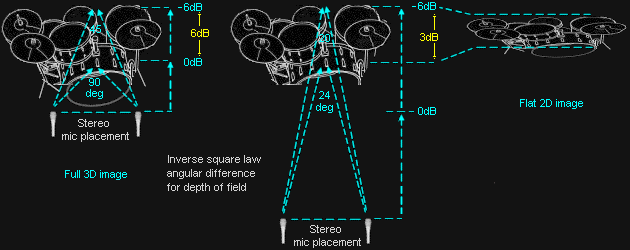
Understanding the spatial distance between mics to enable a depth of field can be viewed geometrically as in the above pic. The inverse square law states that sound energy decreases 6dB (1/4) each doubling of distance. The angular difference between the mics capture a depth of field within a 6dB difference between the front and rear of the sound source. Less than 6dB, the depth will appear flat whereas greater than 6dB the front of the sound source can mask the rear. Its a juggling act similar to focusing a stereo camera lens.

Cinema screen. For cinema, the objective is to make the train (any large sound source) sound as if it is actually present. This means that the sound field has to be heard in the same proportion as the image on the screen. In a commercial cinema the train can appear as its original size, whereas on a home cinema screen the train can only be a fraction of its original size. The recording of the train should be done separately for each application, which is rarely done.
Obtainable objectives
- The listening environment be non-reverberant. Reverberation only in the recording only.
- Minimum numbers of mics with no boundaries or reflections.
- Sound system is full fidelity.
Un-obtainable objectives
- Each mic when recorded be played back separately with its own speaker.
- The playback speakers in the same position as mics.
- The listener be centred.
Romantic un-technical language
The pop recording industry has a disproportional number of so called 'recording engineers' that do not have a background in electro-acoustic technology. Their language is often filled with romantic jargon that has no technical meaning. Regardless of whether microphone understanding is based on mumbo-jumbo or romantic symbolic language and religious attachment to brand names, it should not be dismissed. Many recording engineers may have inadvertently learnt by trial and error, or been informed from someone who passed on interesting techniques. The objective is to discern the technique separately from the non-technical romantic descriptive language. A sense of air, ambience, lightness, creamy, topy, fullness, thickness, fatter, body, open or closed.
A popular April fool joke played on many a non-suspecting brand name junkie pop recording engineer, is being easily fooled by a cheap microphone from radio shack with an imitation Neumann sticker created by someone from the art department, with a fabricated brochure describing it as the latest genetically modified homoerotic laser microphone technology.
Special note. We must remember that the majority of pop music is created for 12-16yr olds. Often over-compressed and downloaded to the lowest fidelity mp3 file. There is no test that can resolve which brand of mic, compressor, effects unit, etc was used to record the music. Also virtually no 12-16 yr old would possibly be interested.
Web sites of Stereo Mic techniques
Innocent Ear by Chris Burmajster (Essential reading)
DPA Microphone University
www.paia.com 'How MS Stereo Works'
www.prosoundweb.com Microphones
www.prosoundweb.com/bruce-bartlett Microphones


